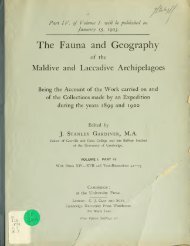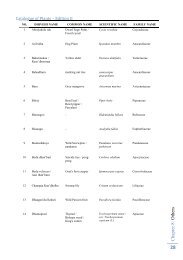694 L. A. BORRADAILE.macrurous groups. For this purpose we must add to the list above certain other characterswhich, either from their own primitive character or because they are found in many of theprimitive members of the groups we are trying to place, may be attributed to the forebearsof these groups : (6) a large gill-formula, including all the gills of the ancestral reptant',(7) a small thorn-like antennal scale", (8) the last pair of legs not only on a free sternum'as in the Potamobiidae and Parastacidae, and slightly twisted at the end as in mostmacrurous Reptantia, but distinctly smaller than the fourth pair, removed from them, andcarried more dorsally, (9) a rather short and broad rostrum, (10) appendices internae onabdominal limbs', (11) a transverse suture on the telson-*.Numbers (6) to (9) of these remove the crustaceans in which they are found from theneighbourhood of the Eryonidea and Scyllaridea, since they are primitive features that thelatter have lost. Numbers (6) and (10) remove them for the same reason from theNephropsidea, to which, nevertheless, they are more akin than to the other macrurous groups.The jaws and the last thoracic sternum, but not the structure of the gills or the grooveson the carapace, are more like those of the Potamobiidae than those of the Nephropsidae.Assuming, as above, a <strong>com</strong>mon descent for the Crabs, Anomala and Thalassinidea, wemust at the same time admit that they very early divided into two widely separatedbranches, one containing the Crabs and the other the remaining groups. The characters bywhich this separation is shown are the following: (1) The great reduction of the abdomenin the Crabs. This is entirely independent of similar developments in the higher Anomala,for the more primitive of the Paguridea and Thalassinidea, though they share the tendency,<strong>com</strong>mon to the whole assemblage of families under discussion, to shelter and protect theirabdomen, have as yet been hardly more affected by it than, say, the burrowing genera ofNephropsidea, which are quite macrurous, while the primitive Galatheidea are little betterin this respect. Moreover, in the Crabs, the reduction has gone so far that the abdomen,having lost its sixth pair of limbs (except for doubtful, unbranched vestiges in some Dromiidea),is now fitted for, and shows traces of. no other function than those connected with reproduction,while in the Anomala and Thalassinidea, though some of its macrurous features arealways reduced, it has kept the sixth pair of limbs and nearly always uses them either forswimming or for holding on a shell. The Lithodinea alone form an exception to this statement,but in them the asymmetry of the abdomen clearly recalls its former use, as in theHermit crabs, to hold on a shell. These two types of abdomen—of which one does, whilethe other does not, show traces of adaptation to some other function than that of reproduction—I propose to call the " brachyurous" and "anomurous" respectively. (2) The carapace, whichin the Anomala and Thalassinidea remains free, is in the Crabs fused with the epistome bothat the sides and (except in Homolodromia) in the middle, under the front. (3) The antennalscale, which in many Anomala and Thalassinidea remains and is moveable, is never found inthat condition in the Crabs. (4) The endopodite of the first maxilliped is broad and hasnearly always an outer angle in the Crabs (see above, p. 425, fig. 110), but has not this shapein the Anomala and Thalassinidea, though some Hippidea approach it. (5) There are neverappendices internae on the abdominal limbs of the Crabs, whereas these structures are presentin most Thalassinidea and some Anomala. (6) The third pair of maxillipeds of the Crabs are' See above, p. 692. This is shown by Jaxea, Homolo- is fused to the stalk.dromia, etc. 3 jjot found in the Crabs.^ Among the Crabs found only in Homolodromia, where it*Found in certain Galatheidea and Paguridea.
MARINE CRUSTACEANS. 695usually broad, forming a cover to the mouth, whereas those of the Thalassinidea and Anomalaare only exceptionally so. These characters, however, are in themselves hardly enough tonegative the supposition that the Crabs have originated from one of the other non-macrurousgroups. What does make it impossible to derive them fi"om the Anomala is the presencein the primitive crab Homolodromia of podobranchs on some of the legs, while an originfrom the Thalassinidea is equally untenable on account of the less primitive condition of thegrooves of the carapace and the reduction of the endopodite and flagellum of the firstmaxilliped in the latter group.We are now left with the Thalassinidea and the three divisions of the Anomala stillunaccounted for. Among these there can be no question that the Thalassinidea are, as awhole, the most primitive. Their straight symmetrical abdomen, with well-developed biramouslimbs on all the segments except the first, and the sixth pair broad and flat in all butThalassina, the presence in most of appendices internae, and in some of good pleura, thesimple legs of the fourth pair and sometimes also of the fifth, the rostrum usually welldeveloped,the moveable antennal scale seldom wholly lost, and the large gill-formulae ofmany genera, extending from the second maxilliped to the fourth leg, with mastigobranchs,podobranchs, arthrobranchs and sometimes pleurobranchs—all these point to the same conclusion.Nor can there be any doubt that the Paguridea and the Thalassinidea are closelyakin and have branched off from the same not very remote ancestor. The only differencesbetween the Axiidae and the primitive Pagurids with symmetrical abdomen such as Pylochelesare the presence of a pleurobranch on the last leg, a suture across the telson in some species(which is never found in Thalassinidea), better developed eyes', the loss of epipodites on thelegs, a reduced rostrum, subchelate legs of the fourth pair, and the branches of the last pairof abdominal limbs narrow and not adapted for swimming. The first three of these features,being primitive, show that the Paguridea are not to be derived from any of the existingThalassinidea and the remainder make it equally impossible to derive the latter group fromthe former. The two meet at a point below otir present horizon.The Galatheidea join the stem from which the last two groups arise before itsbifurcation, that is,- they are less closely akin to either of these than the latter are to oneanother. The fact that they may have epipodites on some of the legs, and the more primitiveshape of the rostrum and sixth pair of abdominal appendages make it impossible to placetheir ancestor within the present limits of the Paguridea. The suture on the telson andthe pleurobranch on the last leg remove it also from the Thalassinidea. And the generalshape of the body, depressed, with broad flat abdomen carrying long pleura and bent underthe thorax, is so different from the <strong>com</strong>pressed body, with straight abdomen, of the primitivePaguridea and Thalassinidea that there can be little doubt that the ancestral Galatheid leftthe non-macrurous stock, after the Crabs indeed, but before it gave rise to the Thalassinidsor Hermit-crabs. As for the linea anomurica, this is found not only in the Galatheidea andPaguridea but also very distinctly in Callianassa novaebritanniae, and it is curious to noticethat it is wanting in the primitive Pagurids such as Pylocheles, and most Thalassinids as inAarius, and that in the Galatheid Aeglea, which is also primitive in many respects, the hinderpart is again wanting. Thus it would seem as though this line appeared only in the higherand more typical forms of each group. The Hippidea present a very difficult problem. On1 Such species as Axiopsis clypeatus, however, have the eyes well developed, though not so large as those of thePaguridea.89—2
- Page 7 and 8:
The Fauna and Geographyof theMaldiv
- Page 9 and 10:
The Fauna and Geographyof theMaldiv
- Page 11:
CONTENTS OF VOL. II.PAKT II.Reports
- Page 14 and 15:
..590 EDGAR A. SMITH.60at3aso-73a
- Page 16 and 17:
—592 EDGAR A. SMITH.3 SC3dSaitnhe
- Page 18 and 19:
,594 EDGAR A. SMITH.3-a ao5j,Moss3
- Page 20 and 21:
.596 EDGAR A. SMITH.3oa o"?!00 >iId
- Page 22 and 23:
598 EDGAR A. SMITH.3isaa'a
- Page 24 and 25:
600 EDGAR A. SMITH.Family ACTAEONID
- Page 26 and 27:
602 EDGAR A. SMITH.23. Conus lividu
- Page 28 and 29:
604 EDGAR A. SMITH,59. Harpa ventri
- Page 30 and 31:
606 EDGAR A. SMITH.Family BUCCINIDA
- Page 32 and 33:
608 EDGAE A. SMITH.below the suture
- Page 34 and 35:
610 EDGAB, A. SMITH.135. Sistrum bi
- Page 36 and 37:
612 EDGAR A. SMITH.173. Cypraea cla
- Page 38 and 39:
614 EDGAR A. SMITH.211. Triforis gr
- Page 40 and 41:
616 EDUAK. A. SMITH.which is a para
- Page 42 and 43:
. 270.618 EDGAE A. SMITH.265. Clanc
- Page 44 and 45:
620 EDGAR A. SMITH.the shell being
- Page 46 and 47:
622 EDGAE A. SMITH.slender riblets
- Page 48 and 49:
624 EDGAR A. SMITH.330. Area (Barba
- Page 50 and 51:
626 EDGAR A. SMITH.FamilyPETRICOLID
- Page 52 and 53:
628 EDGAR A. SMITH.9. Chemnitz. Con
- Page 54 and 55:
630 EDGAR A. SMITH.Fig. 22. Natica
- Page 57:
Plate XXXVI.mii>>-*"^-^ii,.•^16./
- Page 60 and 61:
632 B. C. PUNNETT.Willeyia hisulcat
- Page 62 and 63:
634 R. C. PUNNETT.No. of Specimen.(
- Page 64 and 65:
636 R. C. PUNNETT.Internal structub
- Page 66 and 67:
638 R. C. PUNNETT.The nuchal skelet
- Page 68 and 69:
640 R. C. PUNNETT.deeply sunk posit
- Page 70 and 71:
642 E. C. PUNNETT,but no giant cell
- Page 72 and 73:
644 R. C. PUNNETT.Ptychodera flava,
- Page 74 and 75:
646 R. C. PUNNETT.(PI. XLVI. fig. 4
- Page 76 and 77:
648 R. C. PUNXETT.The racemose orga
- Page 78 and 79:
650 E. C. PUXXETT.vialdivensis proc
- Page 80 and 81:
652 R. C. PUNNETT.Collar. The muscu
- Page 82 and 83:
654 R. C. PUNNETT.Table 5.Pt. flava
- Page 84 and 85:
656 R. C. PUNNETT.whilst the oesoph
- Page 86 and 87:
658 R. C. PUNNETT.is always complet
- Page 88 and 89:
660 R. C. PUNNETT.Lastly there is a
- Page 90 and 91:
662 R. C. PUNNETT.apparently devoid
- Page 92 and 93: 664 R. C. PUNXETT.— '^^S*-!^^- Me
- Page 94 and 95: 666 R. C. PUNNETT.-Scr.— tu« HJ=
- Page 96 and 97: 668 E. C. PUNNETT.I ha\-e therefore
- Page 98 and 99: 670 K. C. PUNNETT.gonad spells incr
- Page 100 and 101: 672 R. C. PUNNETT.Table 11(continue
- Page 102 and 103: 674 R. C. PUNNETT.Table 13.Pt. flav
- Page 104 and 105: 676 R. C. PUNNETT.nlc.
- Page 106 and 107: 678 R. C. PUNNETT.Pig. 37. Ft. flav
- Page 108 and 109: 680 R. C. PUNNETT.PLATE XLV.Fig. 42
- Page 111: Fa-UTia and Geography Maldives and
- Page 115: 'Fauna and Geography Maldives aiid
- Page 119: Fauna and Geography, Maldives and L
- Page 123: Fauna and Geography, Maldives and L
- Page 127: Fauna and Geography, Maldives and L
- Page 130 and 131: (582 L. A. BORRADAILE.typical membe
- Page 132 and 133: 684 L. A. BORRADAILE.arrangement is
- Page 134 and 135: :686 L. A. BORRADAILE.Subfamily Aca
- Page 136 and 137: 688 L- A. BORRADAILE.gaping. The sp
- Page 138 and 139: :690 L. A. BORRADAILE.26. Lambrus (
- Page 140 and 141: 692 L. A. BORRADAILE.(12) The third
- Page 144 and 145: :696 L. A. BORRADAILE.the whole, ho
- Page 146 and 147: 698 L. A. BORRADAILE.2. 6th alxloni
- Page 149: Fauna and Geography, Maldives and L
- Page 156 and 157: 7. Lepidoptera ... .;...... 123Volu
- Page 158: It was supposed that the whole work






